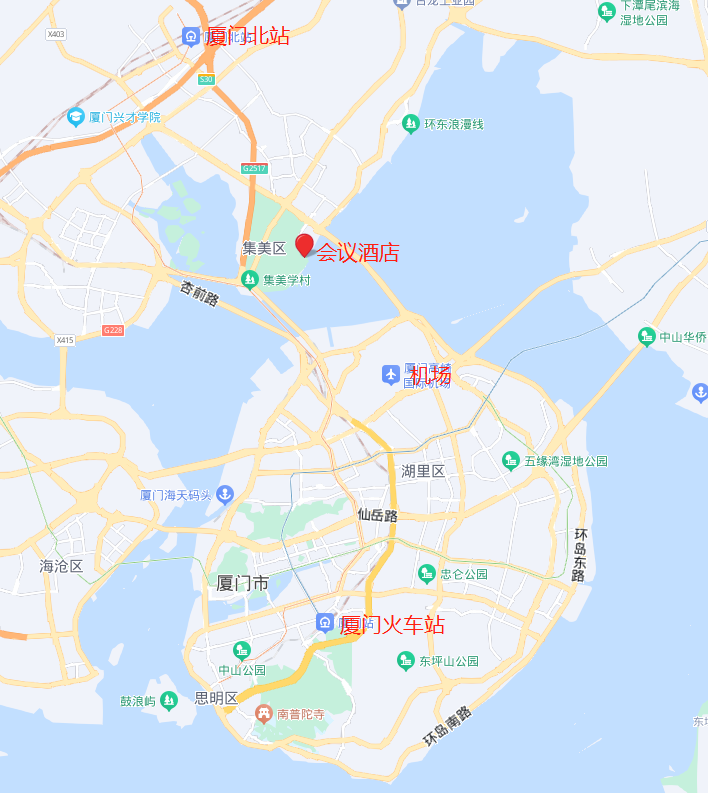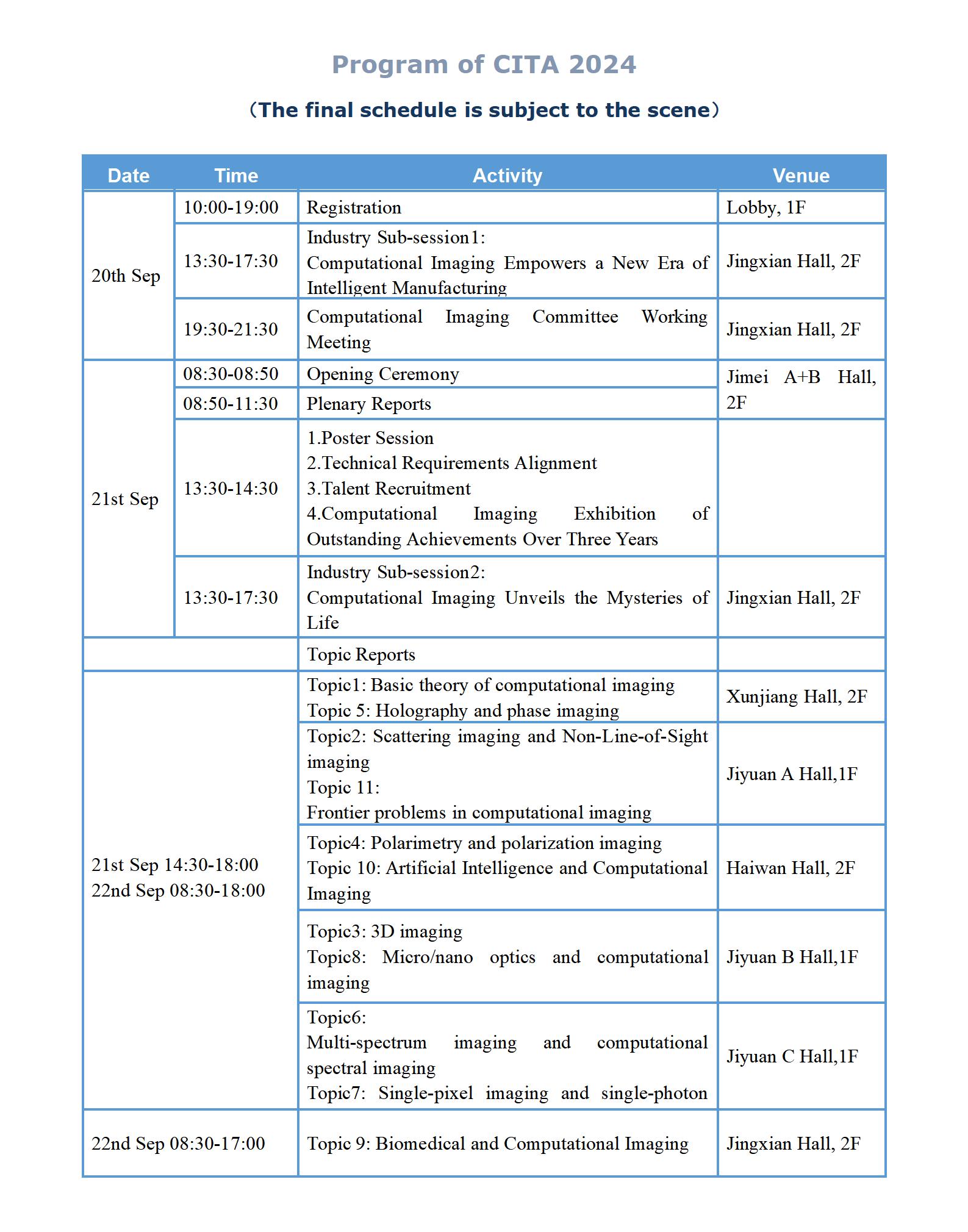Topic 1: Basic theory of computational imaging
•Physical model of computational imaging Technique
•Inverse problem of computational imaging
•Design of the computational imaging architecture system
•Information theory of computational imaging system
•Evaluation of the computational optical imaging system
Chairs:
Zhenrong Zheng (Zhejiang University)
Haoyu Li (Harbin Institute of Technology)
Jinpeng Liu (Xidian University)
Topic Secretary:
Teli Xi (Xidian University)
Topic Assistant:
Haitian Jiang (Tsinghua SIGS)
Reports:
1.Wei Chen (Huazhong University of Science and Technology) — Computational optics for engineering Bessel focus in volumetric two-photon imaging (Keynote)
2.Zhangling Chen (Tianjin Normal University) — Metal artifacts removal for CT reconstruction via adaptive and learned weights
3.Yichen Ding (The University of Texas at Dallas / The University of Texas Southwestern Medical Center) — Characterization of cardiac morphogenesis and contractile function using optical imaging methods
4.Yakun Chang (Beijing Jiaotong University) — High-speed HDR video with spike cameras
5.Zhichang Guo (Harbin Institute of Technology) — Exploring the robustness of deep image despeckling models in an adversarial perspective (Keynote)
6.Xin Liu (The University of Hong Kong) — Free-space wave propagation modeling with least sampling angular spectrum
7. Liying Qu (Harbin Institute of Technology) — Self-inspired learning to denoise for super-resolution fluorescence microscopy
8. Junfei Shen (Sichuan University) — Computational multispectral reconstruction and enhanced imaging
9. Weisong Zhao (Harbin Institute of Technology) — Biomedical imaging empowered by intelligent algorithms (Keynote)
Topic 2: Scattering imaging and non-line-of-sight imaging
•The propagation and Manipulation of light through the scattering medium
•Imaging through the scattering medium
•Non-line-of-sight (around the corner) imaging
•Adaptive optics and wavefront shaping technique
•Time reversal imaging
Chairs:
Jixiong Pu (Huaqiao University)
Puxiang Lai (The Hong Kong Polytechnic University)
Yuecheng Shen (East China Normal University)
Tengfei Wu (Xi'an Institute of Optics and Precision Mechanics of CAS)
Topic Secretary:
Lei Gong (University of Science and Technology of China)
Topic Assistant:
Xinyue Ma (Tsinghua SIGS)
Reports:
1. Chen Wen(The Hong Kong Polytechnic University)— Computational imaging through complex scattering media with single-pixel detection (keynote)
2. Ziyang Chen (Huaqiao University) — The applicaiton of holography in scattering imaging
3. Haowen Liang (SUN YAT-SEN UNIVERSITY) — Functional metasurfaces for defoggy imaging
4. Fei Liu (Xidian University) Research on key techniques for information recovery in scattering light fields
5. Puxiang Lai (The Hong Kong Polytechnic University)— Wavefront shaping-empowered multimode fibers: principles, applications, and perspectives (keynote)
6. Guohai Situ (Shanghai Institute of Optics and Fine Mechanics, Chinese Academy of Sciences) — Learning to image through fog (keynote)
7. Sha Wang (Sichuan University) — Seeing through the scattering medium with low coherence light
8. Yi Xu (Guangdong University of Technology) — Multidimensional information transmission over a multimode fiber
9. Jiamiao Yang (Shanghai Jiao Tong University) — Research and Application of DLP High-Speed High-Precision Optical Field Modulation Technology
10. Meiling Zhou (Xi'an Institute of Optics and Precision Machinery of CAS) — Imaging through scattering media based on spatial modulation of optical fields
Topic 3:3Dimaging
•Structured-light 3D imaging
•Fringe projection profilometry
•Phase Measuring Deflectometry
•Photogrammetry
•Lidar 3D imaging
•Time of flight imaging
•Light field imaging
Chairs:
Chao Zuo (Nanjing University of Science Technology)
Kemao Qian (Nanyang Technological University)
Zhoujie Wu (Sichuan University)
Topic Secretary:
Shijie Feng (Nanjing University of Science Technology)
Topic Assistant:
Hao Geng (Tsinghua SIGS)
Reports:
1. Jianglei Di (Guangdong University of Technology) — Improvement and Application of Digital Holography on use of Deep Learning
2. Shijie Feng (Nanjing University of Science and Technology) — High-speed structured light 3D imaging driven by physics and data(Keynote)
3. Hongzhi Jiang (Beihang University) — 3D precision vision measurement technology based on parallel single-pixel imaging(Keynote)
4. Zhenqi Niu (Shanghai Institute of Optics and Fine Mechanics, CAS) — High-dynamic monoscopic deflectometry research and application for low-spatial-frequency and mid-spatial-frequency error measurement of complex surfaces
5. Xinxing Shao (Southeast University) — Real-time 3D visual deformation measurement method and applications
6. Zhoujie Wu (Sichuan University) — Dynamic 3D reconstruction under complex reflection and transmission conditions using multi-scale parallel single-pixel imaging
7. Xin Yuan (Westlake University) — Recent Advances of Snapshot Compressive Imaging(Keynote)
8. Qingyang Yue (Shandong Normal University) — Single-exposure 3D imaging method for dynamic pecimens
9. Wei Yin (Nanjing University of Science Technology) — Real-time, high-precision, and miniaturized 3D imaging techniques and their applications based on structured light projection
10. Shaohui Zhang (Beijing Institute of Technology) — Autonomous 3D profilometry of unknown objects with efficient backprojection-based next-best-view prediction
11. Junzheng Peng (Jinan University) — Novel 3D imaging techniques based on the principles of dual imaging and single-pixel imaging
Topic 4: Polarimetry and polarization imaging
•Polarization parameter measurement and calibration
•Polarization gating imaging
•Polarization 3D imaging
•Polarized biological microscopic imaging
•Polarization imaging in target detection
Chairs:
Fei Liu (Xidian University)
Honghui He (Tsinghua SIGS)
Xuan Li (Xidian University)
Topic Secretary:
Junchao Zhang (Central South University)
Topic Assistant:
Shuo Chen (Tsinghua SIGS)
Reports:
1. Wei Chen(China University of Mining and Technology)— Semantic segmentation of multimodal remote sensing images with polarization information
2. Zhiguo Fan (Hefei University of Technology)— Split amplitude polarization camera and its applications(keynote)
3.Honghui He(Tsinghua University)— optics for biomedical and clinical applications(keynote)
4.Chao He(Oxford University)— Vectorial adaptive optics(keynote)
5. Ji Qi(zhijiang lab)— computational polarization endoscopy
6.Fan Shi(Tianjin University of Technology)— A Preliminary Study on Intelligent Visual Perception and Polarization Imaging(keynote)
7.Yuanmu Yang(Tsinghua University)— Monocular metasurface camera for single-shot multi-dimensional imaging
8.Yongqiang Zhao(Northwestern Polytechnical University)— Polarized vision(keynote)
Topic 5: Holography and phase imaging
•Holographic interferometry
•Digital holography
•Phase retrieval
•Quantitative phase imaging
•Ptychography imaging & Fourier Ptychography imaging
•Diffraction tomography
•Lensless imaging
Chairs:
Yaping Zhang (Kunming University of Science and Technology)
Renjie Zhou (The Chinese University of Hong Kong)
Edmund Lam (The University of Hong Kong)
Xiao Lin (Fujian Normal University)
Topic Secretary:
Linxian Liu (Shanxi University)
Topic Assistant:
Hongjie Liu(Fujian Normal University)
Reports:
1. Jianying Hao (The University of Tokyo) — Application of deep learning in holographic data storage
2. Tong Ling (Nanyang Technological University) — Quantitative phase imaging of fast neuronal dynamics at the nanometer scale
3. Kebin Shi (Peking University) — Label free imaging with nonlinear and linear holography (Keynote)
4. Tianlong Man (Beijing University of Technology) — Fluorescence self-interference digital holography enables scanning-free multi-dimensional imaging
5. Junwei Min (Xi'an Institute of Optics and Precision Mechanics of CAS) — Quantitative phase imaging and flows visualization
6.Jiachen Wu (Tsinghua University) — Compressive holographic reconstruction using model-driven deep neural network
7. Caojin Yuan (Nanjing Normal University) — The phase-contrast imaging under structured illumination
8. Jinlong Zhu (Huazhong University of Science and Engineering) — “Non-Classical” Quantitative Phase Imaging for 3D Nano-Metrology and Nano-Inspection
9. Chao Zuo (Nanjing University of Science and Technology ) — Computational quantitative phase imaging and diffraction tomography (Keynote)
Topic 6:Multi-spectrum imaging and computational spectral imaging
•Infrared/low light level computational imaging
•THz computational imaging
•Computational multi / high / super spectral imaging techniques
•Coded aperture imaging
•Wavefront encoding imaging
•Super resolution imaging
•Advanced spectrometer design
•Spectral data processing and analysis
•Image fusion technique
Chairs:
Xun Cao (Nanjing University)
Gonzalo Arce (University of Delaware)
Qian Zhou (Tsinghua SIGS)
Zongyin Yang (Zhejiang University)
Topic Secretary:
Shaohui Zhang (Beijing Institute of Technology)
Topic Assistant:
Yiran Li (Tsinghua SIGS)
Reports:
1.Yang Chai (The Hong Kong Polytechnic University) — Bioinspired in-sensor computing for artificial vision (keynote)
2. Renwei Dian (Hunan University) — High spatial resolution hyperspectral computational imaging
3. Zhong Ji (Xidian University ) — Single pixel multispectral imaging
4. Yiming Li (Southern University of Science and Technology) — Data-driven point spread function modeling
5. Quan Liu (Xiamen University) — Progress in speeding up single-point optical spectroscopy(keynote)
6. Xu Ma (Beijing Institute of Technology) — Compressive coded-aperture computational spectral imaging technology
7. Ruyu Ma(Helmholtz Pioneer Campus) — Live-Cell Bioluminescence Microscope
8. Lidai Wang (The City University of Hong Kong) — Multicontrast photoacoustic microscopy(keynote)
9. Jinli Suo (Tsinghua University) — Lightweight High-throughput Computational Imaging by Spectral Encoding
10. Renjie Zhou (The Chinese University of Hong Kong) — Coherence-gated diffraction tomography: from label-free volumetric imaging of single cells to thick tissues
Topic 7: Single-pixel imaging and single-photon imaging
•Basic theory of correlated imaging
•Computation correlated imaging
•Single pixel imaging
•Single photon imaging
•Quantum imaging
Chairs:
Feihu Xu (University of Science and Technology of China)
Weitao Liu (National University of Defense Technology)
Jinyang Liang (Université du Québec)
Topic Secretary:
Dong Wang (Taiyuan University of Technology)
Topic Assistant:
Yuqi Yang (Tsinghua SIGS)
Reports:
1. Enrique Tajahuerce(Universitat Jaume I)—— Computational microscopy with structured light and single-pixel detection (keynote)
2. Jinyang Liang(Université du Québec)—— Compressed ultrahigh-speed single-pixel imaging by swept aggregate patterns(keynote)
3. Yuan Cao(University of Science and Technology of China)—— Quantum-enhanced telescope array(keynote)
4. Baoqing Sun(Shandong University)—— Single-pixel near infrared hyperspectral imaging with optoelectronic spectrum modulation
5. Hao Liu(National University of Defense Technology)—— Multispectral non-line-of-sight imaging
6. Jing Han(Nanjing University of Science and Technology)—— Wide-field non-line-of-sight imaging
7. Jun Ke(Beijing Institute of Technology)—— Object Classification in Single-pixel Imaging
8. Qilin Sun(The Chinese University of Hong Kong, Shenzhen)—— End-to-end Computational Imaging
Topic 8: Micr/nano optics and computational imaging
•Multi-dimensional light field modulation based on micro/nano optics
•Diffraction optics
•metasurface and metalens
•Liquid lens and computational imaging
Chairs:
Dingping Cai (City University of Hong Kong)
Lingling Huang (Beijing Institute of Technology)
Yuanmu Yang (Tsinghua University)
Guixin Li (Southern University of Science and Technology)
Topic Secretary:
Haowen Liang (Sun Yat-sen University)
Topic Assistant:
Yunhui Zeng (Tsinghua SIGS)
Reports:
1.Yanjun Bao(Jinan University) — Metasurface-Based Full-Parameter Single-Shot Real-Time Optical Field Imaging Technology
2.Mu Ku Chen(City University of Hong Kong) — Cascaded meta-devices for novel applications。
3.Xinbin Cheng(Tongji University) — Research Progress in Lightweight and Simple Computational Imaging Systems(keynote)
4.EmilianoR·Martins(University of São Paulo) — Next generation metasufaces and metalenses(keynote)
5.Tao Li(Nanjing University) — Multifunctional bio-imaging based on compact meta-microscope(keynote)
6.Wei Li(Changchun Institute of Optics, Fine Mechanics and Physics, Chinese Academy of Sciences) — Dispersion-assisted high-dimensional photodetection
7.Xin Li(Beijing Institute of Technology) — Novel imaging methods based on metasurfaces
8.Yu Luo(Nanjing University of Aeronautics and Astronautics) — Broadband nonlinear transformation optics
9.Yueqiang HU(Hunan University) — Neural Network-Assisted End-to-End Design for Dispersive Full-Parameter Control of Meta-Optics
10.Ting Xu(Nanjing University) — Multidimensional Imaging Techniques Based on Optical Metasurfaces
11.Guoxing Zheng(Wuhan University) — Research on optical metasurface-based multifunctional image displays
12.Cheng Zhang(Huazhong University of Science and Technology)— Multi-dimensional Optical Field Manipulation using Dielectric Metasurfaces
Topic 9: Biomedical and Computational Imaging
•Super-resolution microscopy
•Deeply-transmission microscopy imaging
•Label-free microscopy
•Ultrasonic imaging
•Photoacoustic imaging / radioacoustic imaging / thermoacoustic imaging
•Optical manipulation & optical tweezers
•Optical Coherence tomography
•NMR-imaging
Chairs:
Baoli Yao (Xi'an Institute of Optics and Precision Mechanics of CAS)
Xianzeng Zhang (Fujian Normal University)
Osamu Matoba (Kobe University)
Jiamiao Yang (Shanghai Jiao Tong University)
Topic Secretary:
Rongjun Shao (Shanghai Jiao Tong University)
Topic Assistant:
Chunxu Ding (Shanghai Jiao Tong University)
Reports:
1. Yu Chen (Fujian Normal University) — Image analysis and evaluation of transplant kidney viability using optical coherence tomography and deep learning
2. Peng Gao (Xidian University) — Large-field structured illumination microscopy for 3D profile and displacement measurement
3. Zhiwei Huang (National University of Singapore) — Depth-coded Stimulated Raman Scattering Tomography for Label-free Biomolecular and Functional 3D Imaging of Live Cells and Tissue (keynote)
4. Wenxuan Liang (University of Science and Technology of China) — Light-efficient mesoscopic SCAPE microscopy
5. Xianlin Song (Nanchang University) — Photoacoustic tomography driven by generative artificial intelligence and its application
6. Fan Wang (Beihang University) — Ion-resonance nanoscale optical tweezers
7. Yunhua Yao (East China Normal University) — Compressive sensing-based high-speed super-resolution microscopy
8. Qing Yang (Zhejiang University) — Frequency domain modulated super-resolution imaging
9. Xibin Yang (Chinese Academy of Sciences) — Research progress and clinical application of advanced endoscopic imaging technology
10. Ran Ye (Nanjing Normal University) — Label-free super-resolution microscopy imaging technology based on microsphere light source
11. Haishan Zeng (University of British Columbia) — In vivo 3-D volumetric multiphoton microscopy imaging of human skin with subcellular resolution and extended field of view (keynote)
Topic 10: Artificial Intelligence and Computational Imaging
•Artificial intelligence and deep learning technology
•Optical System Design Based on Deep Learning
•Computational imaging technology based on deep learning
•Optical neural network
•Optical computing works with a photonic chip
•Computational imaging is supported by big data
Chairs:
Guohai Situ (Shanghai Institute of Optics and Fine Mechanics, Chinese Academy of Sciences)
Yinqiang Zheng(The University of Tokyo)
Jianglei Di (Guangdong University of Technology)
Junfei Shen (Sichuan University)
Topic Secretary:
Jiachen Wu (Tsinghua University)
Topic Assistant:
Yue Xing (Tsinghua SIGS)
Reports:
1. Ni Chen (University of Arizona) — Differentiable Optical Imaging(Keynote)
2. Yikun Liu (Sun Yat-Sen University) — Optical imaging in low visibility and its application
3. Chao Liu (Beihang University) — Liquid lens and its application in computational imaging
4. Yuchen He (Xi'an Jiaotong University) — Research on AI and Ghost Imaging(Keynote)
5. Hongsen He (Xiamen University) — Millimeter-scale protable laser source enables functional photoacoustic microscopy
6. Xiaodi Tan (Fujian Normal University) — Improved Holographic Data Storage by Artificial Intelligence(Keynote)
7. Lu Rong (Beijing University Of Technology) — Terahertz computational tomography based on illumination beam manipulation
8. He Sun (Peking University) — 3D Reconstruction using Ground-based Telescope Videos
9. Shuhe Zhang (Tsinghua University) — Neural near-field goniophotometer
Topic 11: Frontier problems in computational imaging
•SWaP
•Ultra-fast computational imaging
•Bionic computational imaging
•Complex manifold detector
•Photoelectric integrated computational imaging system
•Distributed computational imaging
•Multi-media fusion imaging
Chairs:
Guoan Zheng (University of Connecticut)
Xinbin Cheng (Tongji University)
Xin Yuan (Westlake University)
Haigang Ma (Nanjing University of Science Technology)
Topic Secretary:
Meng Xiang (Xidian University)
Topic Assistant:
Nianchen Shen (Tsinghua SIGS)
Reports:
1. Liheng Bian (Beijing Institute of Technology) — A broadband hyperspectral image sensor with high spatio-temporal resolution
2. Zewei Cai (Shenzhen University) — Programmable aperture light-field microscopy
3. Yan Hu (Nanjing University of Science and Technology) — Adaptive projection of high dynamic 3D imaging of pathological tissue and reverse labeling
4. Xuemei Hu(Nanjing University)—— Efficient Computational Sensing and Intelligent Perception
5. Qiegen Liu (Nanchang University) — Exploiting prior information from the perspective of mask design and application in imaging systems and image processing(keynote)
6. Zhentao Liu (Shanghai Institute of Optics and Fine Mechanics, Chinese Academy of Sciences) — 5D ghost imaging camera based on spatial multiplexing mode
7. Jiawei Ma (CIty Univeristy of Hong Kong) — The Role of Data: Rethinking Advances in Vision-Language Pre-Training for Computational Imaging
8. Mu Qiao (Ningbo University) — Snapshot High-dimentional Compressive Imaging
9. Yujie Xing (Tongji University) — Computational optics enables high-quality imaging despite low manufacturing precision
10. Zibang Zhang (Jinan University) — Single-pixel optical "fire extinguisher"





